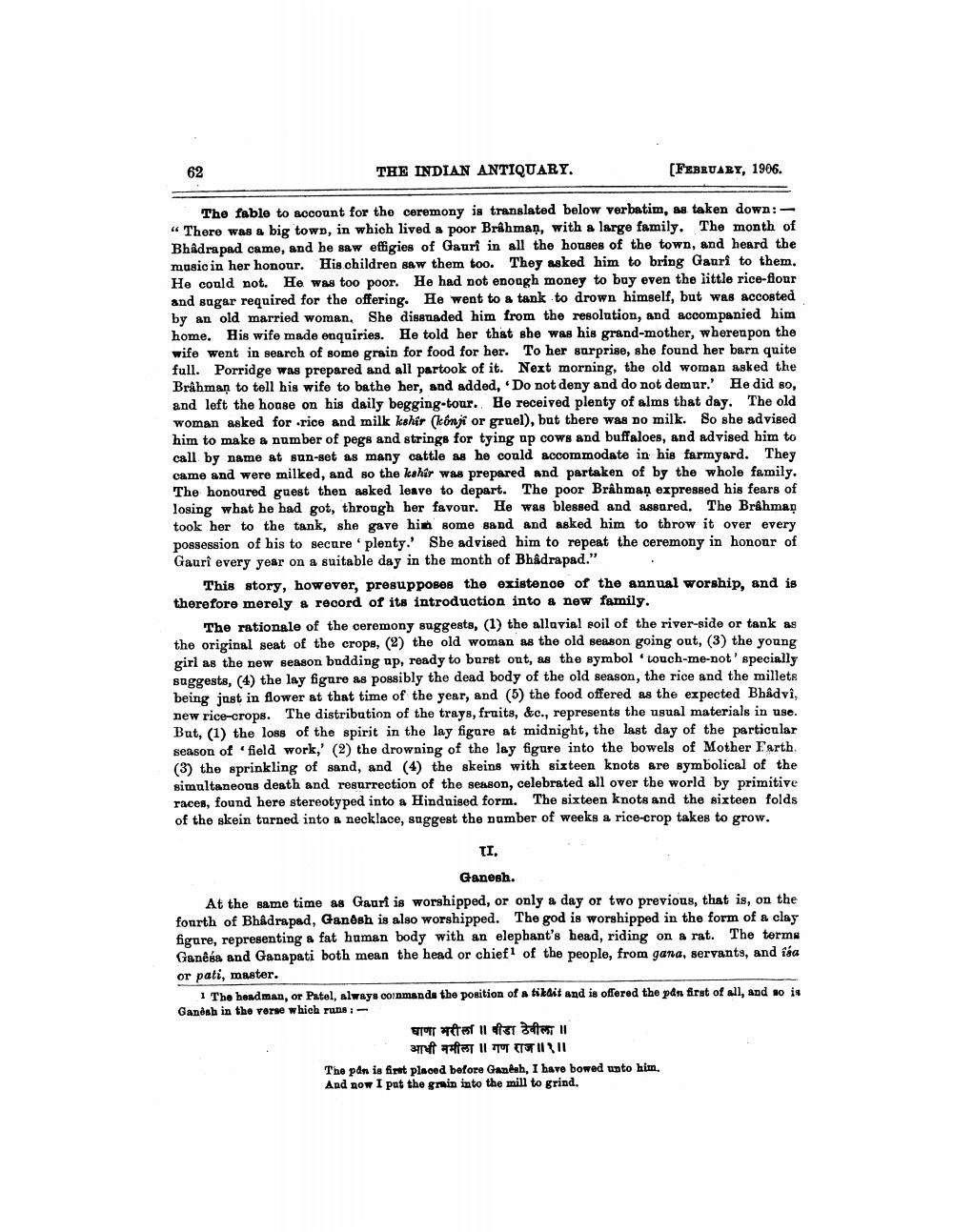________________
62
THE INDIAN ANTIQUARY.
(FEBRUARY, 1906.
The fable to account for the ceremony is translated below verbatim, as taken down: - “There was a big town, in which lived a poor Brahman, with a large family. The month of Bhadrapad came, and he saw effigies of Gauri in all the houses of the town, and heard the music in her honour. His children saw them too. They asked him to bring Gauri to them. He could not. He was too poor. He had not enough money to buy even the little rice-flour and sugar required for the offering. He went to a tank to drown himself, but was accosted by an old married woman. She dissuaded him from the resolution, and accompanied him home. His wife made enquiries. He told her that she was his grand-mother, wherenpon the wife went in search of some grain for food for her. To her surprise, she found her barn quite full. Porridge was prepared and all partook of it. Next morning, the old woman asked the Brahman to tell his wife to bathe her, and added, "Do not deny and do not demur.' He did so, and left the house on his daily begging-tour. He received plenty of alms that day. The old woman asked for rice and milk kahîr (konji or gruel), but there was no milk. So she advised him to make a number of pegs and strings for tying up cows and buffaloes, and advised him to call by name at sun-set as many cattle as he could accommodate in his farmyard. They came and were milked, and so the kshir was prepared and partaken of by the whole family. The honoured guest then asked leave to depart. The poor Brahman expressed his fears of losing what he had got, through her favour. He was blessed and assured. The Brihmad took her to the tank, she gave him some sand and asked him to throw it over every possession of his to secure 'plenty.' She advised him to repeat the ceremony in honour of Gauri every year on a suitable day in the month of Bhadrapad."
This story, however, presupposes the existence of the annual worship, and is therefore merely a record of its introduction into a new family.
The rationale of the ceremony suggests, (1) the allavial soil of the river-side or tank as the original seat of the crops, (2) the old woman as the old season going out, (3) the young girl as the new season budding up, ready to burst out, as the symbol touch-me-not' specially suggests, (4) the lay figare as possibly the dead body of the old season, the rice and the millets being just in flower at that time of the year, and (5) the food offered as the expected Bhâdvi, new rice-crops. The distribution of the trays, fruits, &c., represents the usual materials in use. But, (1) the loss of the spirit in the lay figure at midnight, the last day of the particular season of 'field work,' (2) the drowning of the lay figure into the bowels of Mother Earth. (3) the sprinkling of sand, and (4) the skeins with sixteen knots are symbolical of the simultaneous death and resurrection of the season, celebrated all over the world by primitive races, found here stereotyped into a Hinduised form. The sixteen knots and the sixteen folds of the skein turned into a necklace, suggest the number of weeks a rice-crop takes to grow.
II.
Ganesh. At the same time as Gauri is worshipped, or only a day or two previous, that is, on the fonrth of Bhadrapad, Ganosh is also worshipped. The god is worshipped in the form of a clay figure, representing a fat human body with an elephant's head, riding on a rat. The terms Ganêsa and Ganapati both mean the head or chief of the people, from gana, servants, and isa or pati, master.
1 The headman, or Patel, always commands the position of a tikdit and is offered the pan first of all, and so is Gands in the verge which runs :
STTTT ter il fatto II
आधी नमीला ।। गण राज॥१॥ The pan is firat placed before Ganesh, I have bowed unto him. And now I put the gmin into the mill to grind.




